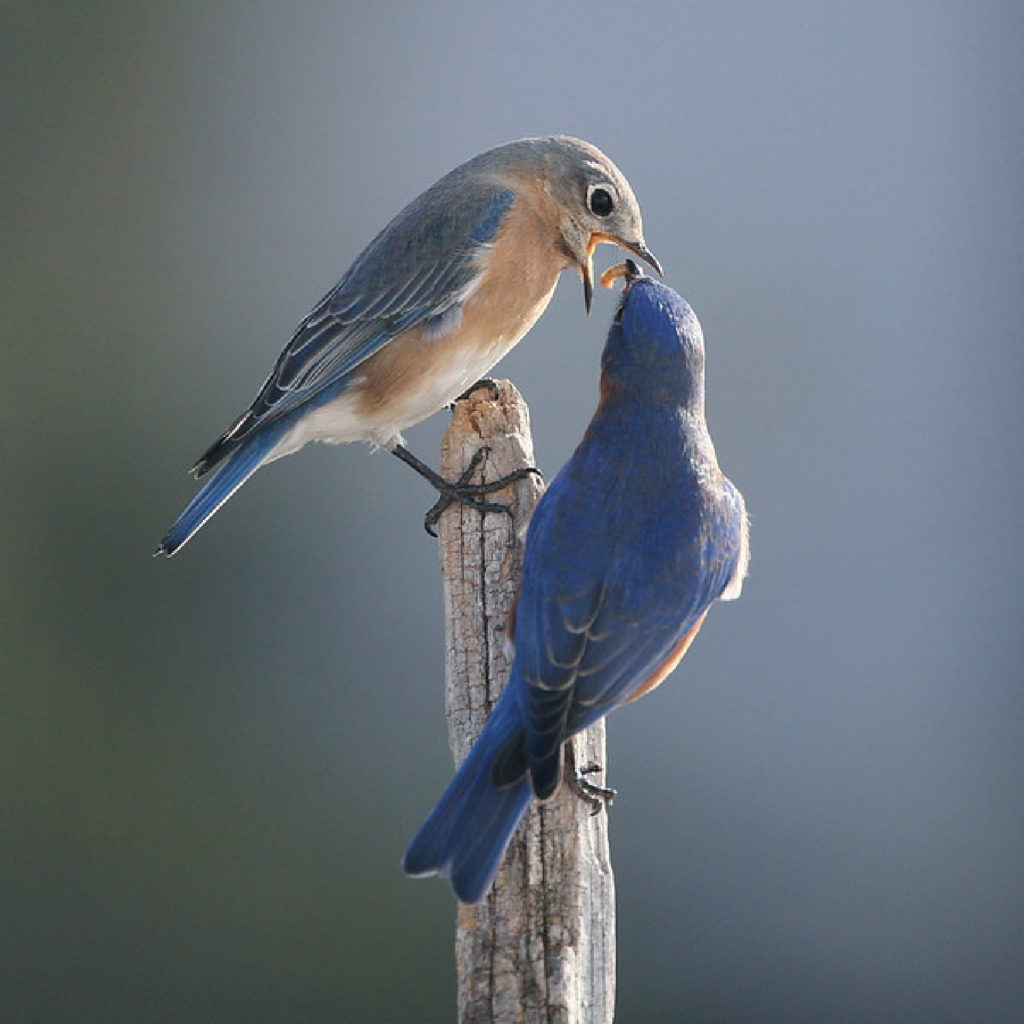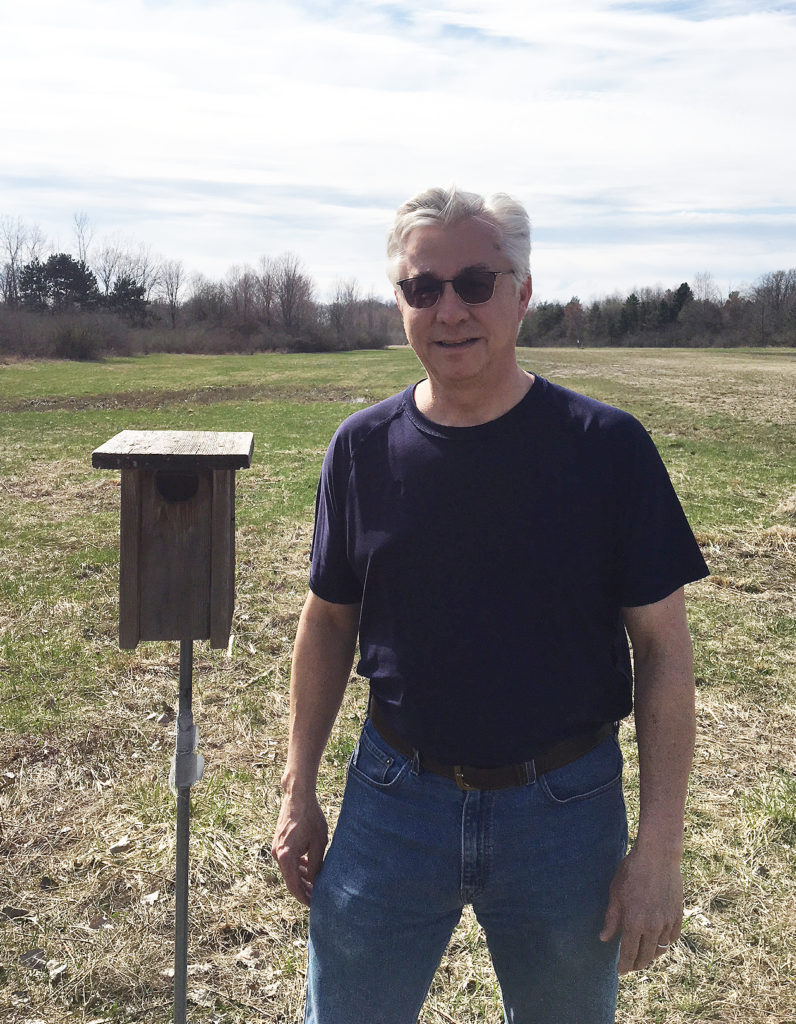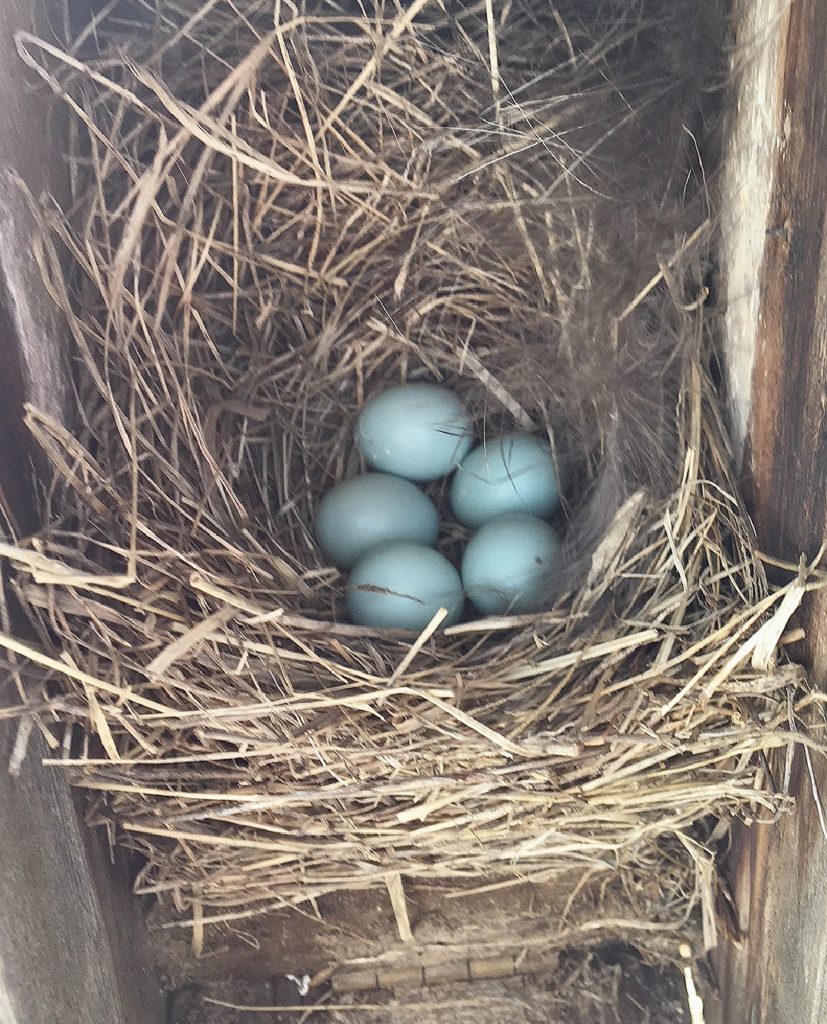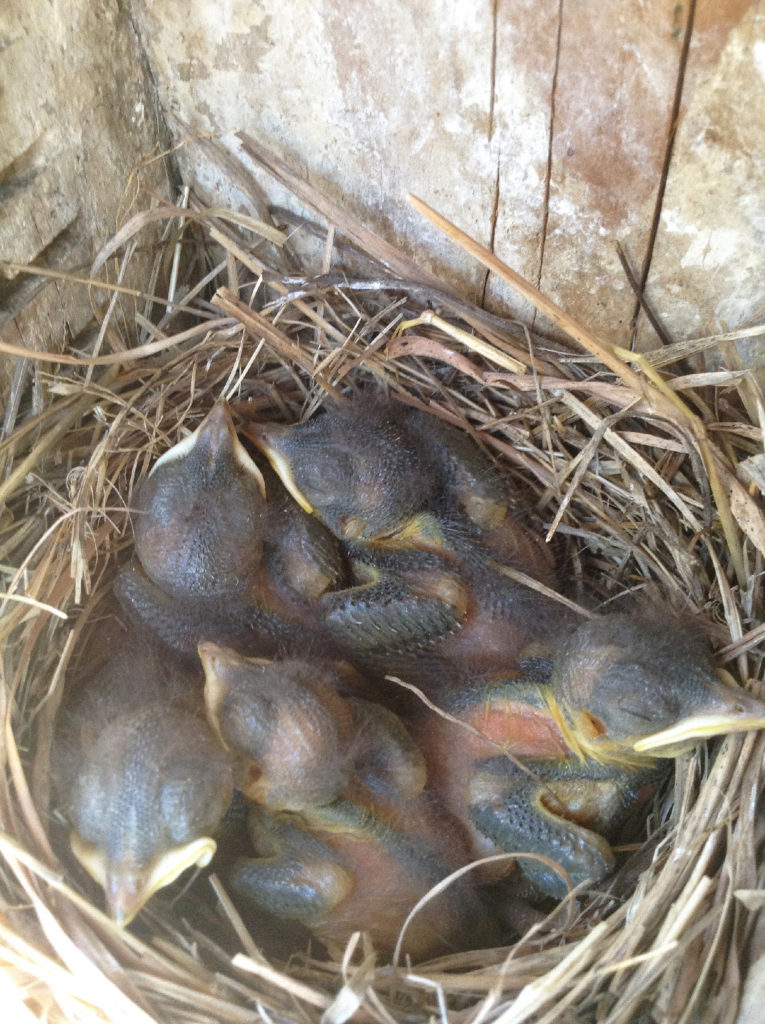By Patsy Isenberg
Bob Wright is not only a financial advisor at Complete Wealth Advisors in Flint, but also a bluebird protector, sustainer, and instructor.
He began his avian pursuit seven years ago in his own backyard on Potter Road when he happened to see one of the gorgeous birds from his kitchen window. Wright already had a birdbath, feeders, suet, and most of the other enticements people use to attract birds to their yards.

Male bluebird feeding a female (Photo courtesy of Dave Kinneer)
But this was the first time he’d seen a bluebird. Wondering why he didn’t see them more often, Wright did some research—soon identifying that it was an actual bluebird, a member of the thrush family of birds native to Michigan, not just a blue bird. He checked out the Michigan Bluebird Society website, www.MichiganBluebirds.org, and got hooked.
So Wright set out to attract more bluebirds to his property. First, he began feeding them mealworms and noticed a little activity. Then he found instructions on how to provide the kinds of nesting places bluebirds like, and put several of those boxes up in his yard.
Becoming a “bluebird landlord”
He’s since become an expert. In a recent presentation to the College Cultural Neighborhood Association (CCNA) Wright explained how to attract the eye-catching birds. His talk was called “Becoming a Bluebird Landlord.”
Bluebirds are “people-shy” and keep to themselves, he said, nesting in cavities, not in the open like many other birds.
But that isn’t the only difference. For example, bluebirds don’t eat birdseed. Their diet consists of non-flying insects, live or dried mealworms, and wild berries in the winter when available.
Also, they’re not predatory, Wright said, which, aside from their beauty, makes them attractive backyard visitors.
Bluebird numbers improving

Bluebird expert Bob Wright with one of his “setups” at For-Mar (Photo by Patsy Isenberg)
For a while, the number of bluebirds in Michigan was on the decline, he said, but lately the numbers have improved as more people get interested in seeing bluebirds and helping preserve and expand their habitat.
The kind of bluebird found in Michigan is the Eastern Bluebird, blue with a brownish-red breast. The male is a slightly deeper blue. Their song is described on the National Geographic website as “chur-lee, chur-lee.”
He says that not much is known about their lifespan, which ones migrate, and where they go if they do. With most birds, banding them is what provides that kind of information. But according to Wright, “banding bluebirds is very difficult. A guy in Traverse City is doing it …but very little data is available.”
It took four years before Wright finally got the bluebirds to live in his yard. Even after he put out the boxes, he noticed “they’d land on them and flitter in and out but wouldn’t build a nest.” They were taking their time and being cautious.
So Wright tried moving the boxes around. “Maybe there’s something about the location … location, location, location!”
Something worked. For the last three years, pairs of bluebirds have been nesting in his boxes and feasting on the food he learned they require.
Active nests at For-Mar
He also has placed several boxes at For-Mar Nature Preserve and Arboretum in Burton, which is where EVM talked to Wright on a perfect early spring day and got to see the setups and nests. One of the nests was “active,” meaning there were beautiful, tiny, blue eggs in it.
The Crim Fitness Foundation recently contacted Wright about working with kids at Pierson Elementary School’s gardening club to learn about bluebirds. And he’s willing to assist individuals with getting started putting setups in their own yards and properties. His services are free; he only asks people to pay for the boxes.

Bluebird nest at For-Mar (Photo by Patsy Isenberg)
Bluebirds like open spaces and because the insects they like to eat don’t fly, the setup should be placed in a low-lying, wide, grassy area as opposed to areas where weeds or tall grass grows around the pole. This gives them access to the insects.
Wright checks the nests that have eggs in them every couple of days.
“Bluebirds will stay in the winter if there’s shelter, and if there’s food, and if there’s water. They need those three things to survive,” Wright said. Wright said he sees the ones on his property all winter. He puts food out all year and plans to get a heated birdbath to keep the water from freezing.
A new pipeline runs through the field where Wright’s setups are located at For-Mar, and For-Mar officials plan to replant that area. He’s urging them to plant bluebird-friendly plants native to Michigan that produce berries, like holly and chokeberry, which the bluebirds can eat all winter.
The boxes do need attention, though. Wright says to check them a couple times a week for blowflies or other invasive insects — or any other predatory threat — by brushing away anything suspicious from the box. Wright saves old nests that are in good condition so that he can put a new one in a box if needed, or he evenmakes them himself.

Bluebird nestlings (Photo by Bob Wright, who offers a challenge: how many birdies? Hint: count the beaks.)
Bluebird myths
He says it’s a myth that birds reject nests or eggs and newly hatched baby birds touched by people. He’s done it, and has even picked up young fledglings and put them into a replacement nest when needed. “She [the mother bird] will go back. That bond is incredibly strong,” he said.“Birds have a very weak — if any — sense of smell.”
Wright is generous about sharing information about the bluebird, and he’s clearly passionate about it. He comments on the idea that so many people mistakenly think that a bird that’s blue is a bluebird. But through his initial research, he discovered that the bluebird is a very desirable native bird whose population needs help to flourish.
He remembers his reaction when he first got into bluebirds: “Oh my gosh, there’s this whole world out there that I don’t know anything about, and the more you get into it — I mean, the kids are grown, you come home in the evening and you’ve got nothing to do … you’re outside, you’re doing something neat and something cool and helping out.”
Attracting bluebirds could be a fun project for residents to do individually or as a neighborhood engagement project, if you’ve got about an acre of land, according to Wright. Not only is it enjoyable, but it could help increase the population of native bluebirds. Wright offers more information at mibluebirds@gmail.com or 810-919-6061 for questions or how to attract bluebirds to your property.
EVM staff writer Patsy Isenberg can be reached as pisenber@gmail.com.


You must be logged in to post a comment.